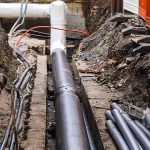The Oily Dilemma: Responsible Disposal of Oily Water for Businesses
Oily water, a byproduct of industrial processes, presents a significant environmental challenge, and businesses across Australia, from automotive workshops to manufacturing plants, generate this complex waste stream. Managing oily water responsibly is not just a legal obligation; it’s a crucial step in protecting our waterways and ecosystems. This article explores the challenges and regulations surrounding oily water disposal, offering guidance on best practices for businesses, as understanding the intricacies of oily water removal and processing is paramount for maintaining environmental compliance and fostering a sustainable future.
Understanding Oily Water and Its Impact
Oily water is a mixture of water and hydrocarbons, often containing other contaminants like suspended solids, metals, and chemicals. It is generated in a range of industrial activities, including vehicle washing, machinery maintenance, metalworking, and food processing, and the presence of oil in water can have devastating consequences for the environment. It can create a film on the water’s surface, hindering oxygen transfer and harming aquatic life. Furthermore, oily water can contaminate soil and groundwater, posing risks to human health and ecosystems. Effective oily water disposal is therefore essential to mitigate these potential harms.
Regulations and Compliance for Oily Water Disposal
In Australia, the disposal of oily water is strictly regulated at both the federal and state levels. These regulations aim to protect the environment and ensure responsible waste management practices. The Environment Protection and Biodiversity Conservation Act 1999 (EPBC Act) provides a national framework for environmental protection, while state-specific legislation outlines detailed requirements for waste management, including oily water. These regulations often cover aspects like waste oil classification, storage, transport, treatment, and disposal. It is crucial for businesses to be aware of the specific regulations applicable to their operations and location, and businesses must adhere to these regulations to avoid penalties and contribute to environmental sustainability.
Oily Waters Removal and Processing Methods
Several methods are employed for oily waters removal and processing, each with its own advantages and limitations. These methods aim to separate the oil from the water, allowing for the treated water to be discharged safely or reused, and the oil to be recovered or disposed of appropriately. Common techniques include:
- Gravity Separation: This method relies on the difference in density between oil and water. The oily water is held in a tank, allowing the oil to rise to the surface where it can be skimmed off. This is a relatively simple and cost-effective method, suitable for applications with larger oil droplets.
- Coalescence: This process uses materials that attract oil droplets, causing them to combine into larger droplets that are easier to separate. This process can utilise coalescing filters or plates.
- Filtration: Various types of filters can be used to remove oil and other contaminants from water. These can range from simple mechanical filters to more advanced membrane filtration systems.
- Biological Treatment: In some cases, biological treatment methods can be used to break down oil and other organic contaminants in wastewater. This involves using microorganisms to consume the pollutants.
The selection of the appropriate treatment method depends on the specific characteristics of the oily water, including the type and concentration of oil, the presence of other contaminants, and the volume of wastewater generated.
Waste Oil Management and Disposal
Waste oil, separated from oily water, requires careful management and disposal. It is classified as hazardous waste and cannot be disposed of through regular waste streams. Waste oil can be recycled or re-refined for use as a fuel or lubricant. Alternatively, it can be disposed of by a licensed waste disposal company. Proper waste oil disposal is vital to prevent environmental contamination and comply with regulations, and Clarence Valley Septics can provide expert advice and services for waste oil collection and disposal, ensuring that your business meets all regulatory requirements.
Best Practices for Oily Water Management
Implementing best practices for oily water management is essential for minimising environmental impact and ensuring regulatory compliance. These practices include:
- Preventing spills and leaks: Implementing measures to prevent spills and leaks of oil and other contaminants is crucial. This includes regular inspection and maintenance of equipment, proper storage of chemicals, and spill response training for employees.
- Minimising water usage: Reducing the amount of water used in industrial processes can minimise the volume of oily water generated. This can be achieved through water recycling and reuse, as well as implementing water-efficient technologies.
- Regular monitoring and testing: Regular monitoring and testing of oily water are essential to ensure that treatment systems are operating effectively and that discharge limits are being met.
- Proper record keeping: Maintaining accurate records of oily water generation, treatment, and disposal is essential for demonstrating compliance with regulations.
The Responsible Disposal of Oily Water – In Conclusion
Responsible oily water disposal is a critical aspect of environmental management for businesses across Australia. By understanding the regulations, implementing best practices, and utilising appropriate treatment technologies, businesses can minimise their environmental impact and contribute to a sustainable future. Clarence Valley Septics is committed to helping businesses navigate the complexities of oily water management, offering expert advice and tailored solutions to meet their specific needs.
Contact Us
Are you facing challenges with oily water disposal? Contact Clarence Valley Septics today for a consultation. Our team of experts can assess your needs and provide solutions for oily water removal, waste oil management, and regulatory compliance. Let us help you protect the environment and ensure that your business operates legally and sustainably. Call us now on +61 2 6645 3100 or send us a message via our website for more information.


